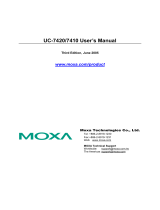
MC-1200 Series Linux UM Software Configuration
Inserting a USB Storage Device into the
Computer
By default, the USB storage devices on the MC-1200 will not be mounted automatically. You have to mount the
storage devices manually. Since mounting USB storage devices manually can be difficult, a Debian package
called
usbmount is available to mount the USB drivers automatically. The usbmount package relies on the
udev package to mount the USB storage devices automatically on certain mounting points such as
/media/usb0 and /media/usb1.
sysfs on /sys type sysfs (rw,nosuid,nodev,noexec,relatime)
proc on /proc type proc (rw,nosuid,nodev,noexec,relatime)
udev on /dev type devtmpfs (rw,relatime,size=10240k,nr_inodes=492181,mode=755)
devpts on /dev/pts type devpts
(rw,nosuid,noexec,relatime,gid=5,mode=620,ptmxmode=000)
tmpfs on /run type tmpfs (rw,nosuid,relatime,size=790820k,mode=755)
/dev/sda1 on / type ext4 (rw,noatime,errors=remount-ro,data=ordered)
securityfs on /sys/kernel/security type securityfs
(rw,nosuid,nodev,noexec,relatime)
tmpfs on /dev/shm type tmpfs (rw,nosuid,nodev)
tmpfs on /run/lock type tmpfs (rw,nosuid,nodev,noexec,relatime,size=5120k)
tmpfs on /sys/fs/cgroup type tmpfs (ro,nosuid,nodev,noexec,mode=755)
cgroup on /sys/fs/cgroup/systemd type cgroup
(rw,nosuid,nodev,noexec,relatime,xattr,release_agent=/lib/systemd/systemd-cgrou
ps
-agent,name=systemd)
pstore on /sys/fs/pstore type pstore (rw,nosuid,nodev,noexec,relatime)
cgroup on /sys/fs/cgroup/cpuset type cgroup
(rw,nosuid,nodev,noexec,relatime,cpuset)
cgroup on /sys/fs/cgroup/cpu,cpuacct type cgroup
(rw,nosuid,nodev,noexec,relatime,cpu,cpuacct)
cgroup on /sys/fs/cgroup/devices type cgroup
(rw,nosuid,nodev,noexec,relatime,devices)
cgroup on /sys/fs/cgroup/freezer type cgroup
(rw,nosuid,nodev,noexec,relatime,freezer)
cgroup on /sys/fs/cgroup/net_cls,net_prio type cgroup
(rw,nosuid,nodev,noexec,relatime,net_cls,net_prio)
cgroup on /sys/fs/cgroup/blkio type cgroup
(rw,nosuid,nodev,noexec,relatime,blkio)
cgroup on /sys/fs/cgroup/perf_event type cgroup
(rw,nosuid,nodev,noexec,relatime,perf_event)
tmpfs on /etc/machine-id type tmpfs (ro,relatime,size=790820k,mode=755)
systemd-1 on /proc/sys/fs/binfmt_misc type autofs
(rw,relatime,fd=21,pgrp=1,timeout=300,minproto=5,maxproto=5,direct)
hugetlbfs on /dev/hugepages type hugetlbfs (rw,relatime)
mqueue on /dev/mqueue type mqueue (rw,relatime)
debugfs on /sys/kernel/debug type debugfs (rw,relatime)
binfmt_misc on /proc/sys/fs/binfmt_misc type binfmt_misc (rw,relatime)
/dev/sdb1 on /media/usb0 type vfat
(rw,nodev,noexec,noatime,nodiratime,sync,fmask=0022,dmask=0022,codepage=437,ioc
ha
rset=utf8,shortname=mixed,errors=remount-ro)
/dev/sdc1 on /media/usb1 type vfat
(rw,nodev,noexec,noatime,nodiratime,sync,fmask=0022,dmask=0022,codepage=437,ioc
























